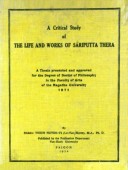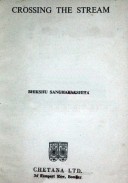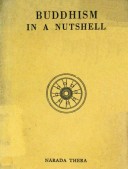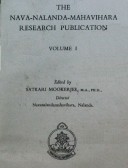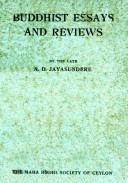Tìm Sách
Sách tiếng Anh-English >> The Life & Works of Sariputta Thera
Thông tin tra cứu
- Tên sách : The Life & Works of Sariputta Thera
- Tác giả : Thich Huyen Vi
- Dịch giả :
- Ngôn ngữ : Anh
- Số trang : 319
- Nhà xuất bản : Van Hanh University
- Năm xuất bản : 1972
- Phân loại : Sách tiếng Anh-English
- MCB : 1210000002641
- OPAC :
- Tóm tắt :
FOREWORD
A good deal of research on the life and teachings of Lord Buddha hat already been done. But comparatively little has been done on the life and works of His disciples. Of course nothing much is known about most of them except that they joined the Sangha and after due endaevours attained the various stages of sainthood. However, fortunately for us, the tradition has preserved the life accounts of the most Important among them. This is specially true of Asiti mahãsãvakas or eighty great disciples who were well known for their spiritual attainments and achievements. Among them, by virtue of merit, Sariputta was accorded the first piece, and he became Aggamahàsàvaka or the chief disciple of the Master.
In fact, Sàriputta was only next to the Master in his attainments and achievements. In the words of the Master himself it too Sàriputta who turned the Wheel of Low after Him (Dhammacakkam anuppavatteti). It if on record that on several occasions the Buddha advised His other disciples to follow the noble example of Sariputta in spiritual discipline. Sàriputta played the most important part in conducting the affairs of the Sangha and promoting the welfare of Saddharma.
So dominating was the personality of Sàriputta vis-a-vis the and the Buddha-sasana that on his parinibbàna it left a big vacuum. There are several significant statements on the point ascribed to the Master. When the Buddha attended the first assembly of the Sangha after the parinibbàna of Siriputta, deep silence prevailed for sometime and then breaking it He remarked that without Sariputta the Sangha appeared to be rather desolate. On another occasion, also immediately after Sariputta’s pannibbana, white addressing another assembly of His disciples at Ukkàcela, the Lord referred to the absence of His chief disciple. On this occasion He compared the Sangha to a big and beautiful spreading tree and Sàriputta to its biggest branch. Now that branch which enhanced its beauty was no more and the big tree was looking out of shape. These touching remarks bear ample testimony to the high esteem that Sàriputta stood in the eye of the Master.
Accounts of the life of the great saint are found scattered in various Nikàyas and their commentaries. But so far no systematic work was available on the subject matter. This need has been fulfilled in the present work by Ven. Bhikshu Thick Huyen-Vi.
In this work the author has coveted all the important aspect of the life of Sàrĩputta — life from birth to parinibbàna, achievements and qualities, spiritual evolution, and work and discourse.
The present work is mainly based of materials available in the Pali literature — both canonical and exegetical. The author has also drawn upon the Chinese accounts which are based on Sarvàstivàdin and Mahàyàna traditions. While there is agreement on the main points, there are some differences on minor points. It appears that the various traditions’ borrowed their materials from a common source and worked out the details according to their Interest. It may be noted here in pasting that since the accounts that have come down to us in other traditions are rather scanty, one has to depend on the Pàli tradition to present anything nice a full picture of the life and mission of the great saint.
While dealing with the contents of the discourse of Sàriputta, the author has made a comparative study of them as found In the Pàli and Chinese versions, the latter being the translations of the Ãgamas. He has tried his best to make the work as comprehensive as possible. His knowledge of Pali and Chinese has stood him in good stead in this work.
The life of a saint can never be a colourful one and therefore of general Interest. It is the life of the man of the world whose Interests are legion and who plays many roles that could be colourful. His is a life of multiplicity (papanca) full of attractive features and hence it could create distractions and thrilling sensations for the average man of the world. On the contrary the saint has to lead a disciplined and dedicated life away from the complications and distractions of the world. He has to attain the mental unification and Integration by following the spiritual path. It Is one of simplification, purification and penetration. By following this path he has to go beyond the sense sphere and attain that Inner stillness where the mystery of life is revealed and the ultimate Truth Is realized. This is true, mutatis mutandis, even of a man given to unravelling the mysteries of the phenomenal world. A scientist too has to lead a dedicated life. He has to forego many good things of the world which the average man may enjoy. He has to find his delight in his discoveries which are also thrilling but of a higher nature. If he is lacking in this spirit his work would suffer to the same extent.
The life of a saint Is valuable for the light it sheds on the spiritual path. This is true of Arahanta Sariputta also. His life was a noble example of sila or virtue, samàdhi or concentration and pa or Intuitive wisdom. These divine qualities found their fulfilment in his life.
For most people spiritual life is associated with the attainment of supernormal powers leading to the performance of miracles. It is true that they are a by-product of the higher life and are often attributed to great saints. But they have never been upheld as a sure criterion of spiritual attainments. In fact too much interest in them could even be a hindrance on the spiritual path. For the same reason, Lord Buddha, as laid down in the Vinaya rule No. Sit made it an offence for His disciples to perform miracles. Life of Sàriputta stands as an illuminating vindication of this matter. Although he had attained, like other great Arahantes, all the supernormal powers, yet, as recorded in the Theragathà, he did not take eng interest in the practice and performance of miracles (Iddhi). Then again, this advice to Anuruddha Thera is illustrative of this point. Anuruddha was the foremost among those disciples of the Tathàgala who were proficient in the performance of miracles. With ell the supernormal powers Anuruddha, in the beginning, was not able to attain the spiritual stages. He did not know the fact that in those who are still in the mundane plane (lokiya-bhumi) ego works in a very subtle form in relation to the psychic powers. When he failed in Ms endeavours, he went to Sàriputta for guidance. The former told the latter that in spite of his psychic powers he was not able to attain the spiritual stapes. Sàriputta at once pointed out to him where the rub was. He told him that it was the vanity of psychic powers which created hindrance for him, and then advised him to direct his mind towards the state of immortality. By acting in the light of his instructions Anuruddha was able to attain the highest state of sainthood (arahatta) before long.
It is true that Lord Buddha and some of his enlightened disciples made use of the psychic powers occasionally, and that only to direct the minds of certain individuals towards the spiritual path. But then in the case of those who are still in the mundane plane, they can do more harm than good. Devadatta’s is a glaring example. After attaining some psychic powers he became so crazy for name, fame and gain that he lost all good sense. His ambition dragged Mm down to the lowest depth of degradation. Sariputta’s life illustrates the futility of psychic powers in the attainment of spiritual emancipation.
With all his material prosperity man is not happy today. The reason his that he has lost sight of the higher values of life. Man can attain peace and happiness only by regaining the right perspective of life. It is a good sign that in certain quarters they have begun to revaluate the values of life. In this the life and teachings of great saints like Sàriputta can guide them in the right direction. They serve like beacon lights in a world lost in spiritual darkness. The present work can serve this purpose.
Having the knowledge of Pàli and Chinese Ven. Bhikshu Thich Huyen-Vi Is well equipped to serve the cause of Saddharma in a wider sense. While congratulating him on his present work, I wish him further success in this line.
Ven. Dr. V. Dhammaratana M.A., D. Phil.,
Professor of Pàli and Buddhis-Philosophy
Nava Nàlandà Mahàvihàra,
Patna, Bihar, India.
8-9-1971.
PREFACE
It is with great honour and pleasure that Van Hanh Publication Department has brought about the publication of Venerable Thick Huyen Vi’s thesis on: “A critical study of The Life and Works of Sàriputta Thera”.
The work is commendable in itself, in that, it deals with Sàriputta Thera, one of the most prominent disciples of the Buddha, the foremost in wisdom. Not only wisdom it the ultimate aspiration for all those who want to follow the steps of the Buddha, it is inscribed in the motto of Van Hanh University itself: “Duy Tue Thi Nghiep”. And if we care to analyse the difference in between Kamma or action and Pannà or wisdom, the world of desire (Kàmàvacara) it dominated by Kamma, while in the Lokuttara or transcendental world, Pannà replaces Kamma. So we have here a meeting ground in wisdom which it best represented by Sáriputta Thera himself.
Further more Venerable Thick Huyen Vi is well known to us for a long time. We still remember the time, about 1964, when we welcomed him for the first time at Nalanda where he came for study, with a scanty knowledge of English and with no knowledge at all in Pàli. But we had full confidence in him. at he had left a train of good work done at home in Vietnam, both at excellent preacher and as devotional worker in various Dhamma activities. He did not belie in our expectation, and the present thesis. 4 years of hard work after hit M.A. bears living testimony to hit excellent works in matter of research and study.
In Vietnam, such kind of research work is rather rare, if not inexistent. Either a Buddhist selects a sutta and devotes his own life, for study and practice and feels quite satisfied with it. He has no time or no training to bother himself with other innumerable discourses dealing with the same topics. Or he considers study or book a kind of palibodha or impediment to his spiritual training, and that too should be discarded. We think that this excellent work done by Venerable Thick Huyen Vi it a kind of eye-opener to many short-sighted people and toe hope that our publication at least fulfills this moderate aim.
As the author it still at Nàlandà, while the printing it done in Vietnam, some mistakes are bound to occur, when consultation of any kind is virtually impossible. The author does not follow strictly the alphabetical order (either English or Pall) in hit indexes, for to hat reason unknow to 99. So toe prefer to respect hit arrangements. At for diatrical marks for Pali and Sanskrit terms, both languages are still not in use in the printing press of Saigon. So please forgive any lapses that occur. The Chinese terms are not a problem in Vietnam. At least we hope to.
The cost of the publication is covered by many donors to ho. are mostly Venerable Thich Huyen Vi’s disciples. So a list of them is printed at the end of the book in recognition of their contribution.
enerable Thich Minh Chau
Rector
Van Hanh University
Saigon January 1972.
CONTENTS
Introduction
I. CHAPTER ONE Life of Sàriputta
Section 1 Family Members
Section 2 Education
Section 3 Renunciation
Section 4 Spiritual Attainments
Section 5 Mission
Section 6 Parinibbàna
II. CHAPTER TWO Achievements end Qualities of Sariputta
Section 1 Wisdom
Section 2 Devotion to the Master
Section 3 Place in the Sangha
Section 4 Close Associates
Section 5 Influence on Family Members
Section 6 Influence cm others
Section 7 Disciples
III. CHAPTER THREE Spiritual Evolution of Sàriputta
Section 1 Three-fold Bodhi:
- Sammàaambodhi
- Paccekabodhi
- Sàvakabodhi
Section 2 Bodhi of the Chief Disciple
Section 3 Legends on the Spiritual Evolution
IV. CHAPTER FOUR Works and Discourses of Sãriputta
Section 1 Abhidhamraa
Section 2 Patisambhidàmagga
Section 3 Niddesa
Section 4 Discourses of Sàriputta
- Dĩghanikàya
- Majjhimanikaya
- Samyuttanikàya
- Anguttaranikàya
Section 5 Classification of the Suttas according to their topics
CONCLUSION
Appendixes
Index of some Doctrinal Terms
Index of Chinese Terms
Bibliography
 Facebook
Facebook
 Google
Google
 Google+
Google+
